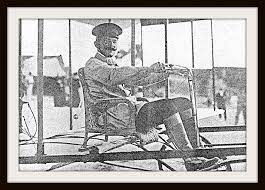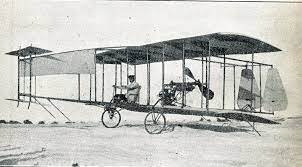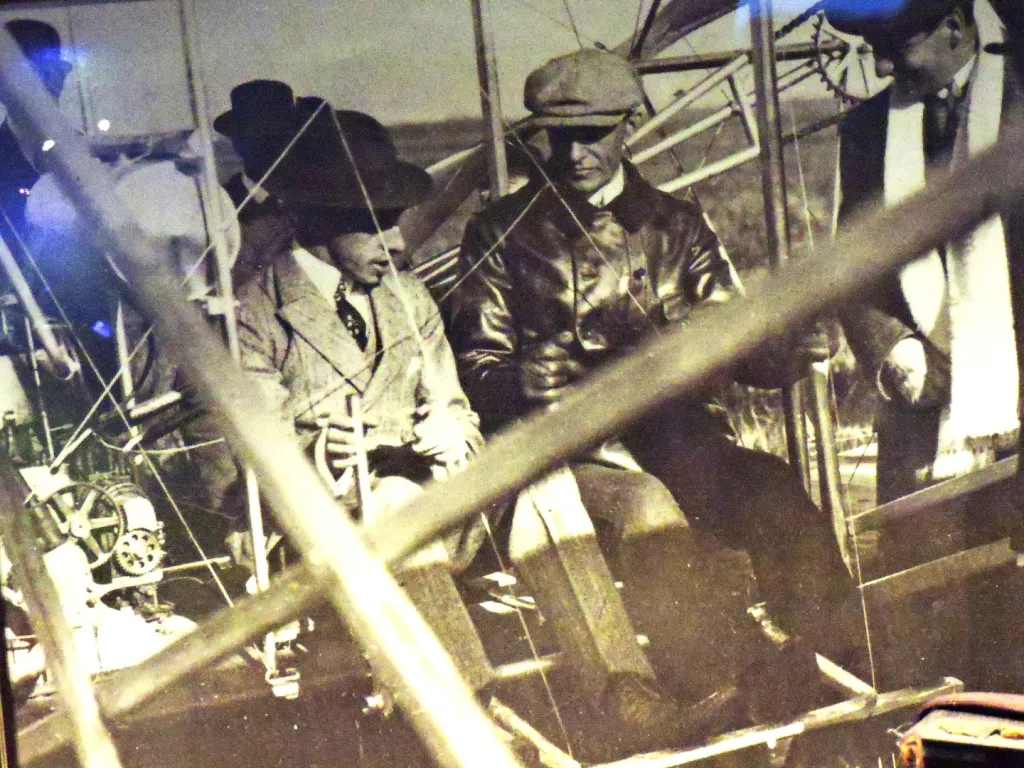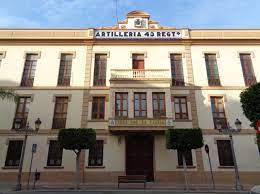It was in Valencia that, for the first time in Spain, a man flew in a motorised aircraft, even if it was only a for a few metres. That place was Paterna and at the controls of the aeroplane was Juan Olivert Serra, an aviation pioneer…
It may seem comical, this short journey, seen from a modern perspective of long-haul international air travel. But if we go back more than a century, to 1909, perhaps what Olivert did cannot be seen in any other way than as a small feat and an act of courage that helped to usher in the age of air travel.
Juan Olivert was the first to fly in Spain.
Juan Olivert was born in Cullera in 1888 and from a very young age he was attracted to flying, however it happened, and later to aviation, which at that time was something completely new. His parents did not look very favourably on his dreams, and it is even said that in his home town he was called voladoret because of his determination to leave the ground and fly, according to Escapada Rural Mag.
Attracted by the world of machines, he studied industrial engineering in Barcelona. Together with one of his professors, Gaspar Brunet Vadera, he set out to build an aeroplane. In 1908, an association formed in Barcelona for the dissemination of the incipient aeronautics and Brunet was one of the founders, being also a pioneer in the world of the academy on aeroplanes and how to fly in the best possible way. United by that dream, the two collaborated to create an aircraft. Brunet had thought long and hard about how to do it, and Olivert raised the necessary funding to get the project off the ground. Part of the funding even came from a lottery prize.

Thus, in the Industry Pavilion of the 1909 Valencia Regional Exhibition, Olivert and Brunet’s apparatus was a real eye-catcher, even though it did not yet have an engine installed. Shortly afterwards, the Valencia City Council paid for the engine, apparently after King Alfonso XIII intervened to finance it.
But of course, an aeroplane is not just for display, it is actually something designed to fly. It would have been magnificent if the aeroplane had flown from its place of manufacture in Barcelona to Valencia. Unfortunately Olivert and Brunet were still a long way from that and the aircraft travelled by train. It did not even have an engine yet. But it would fly, as its creators were determined to fit one. And that finally happened on 5 September 1909.
The first Spanish aerodrome was at Paterna
On land owned by the Spanish Army in Paterna there was a runway sufficiently smooth and clear to serve as an aerodrome. On the afternoon of that September day, some 4,000 people gathered to witness the first powered flight in Spain. It was an event, with Olivert at the controls, that was not in the script.
Olivert had invited some personalities to visit him at that place in Paterna, where he had planned to do a taxiing test and show the aeroplane to those few personalities. But the press reported the event, quoted the place and assured that the plane was going to fly. All this forced Olivert to go a step further than he had planned, driven by the fevered expectation. Neither the pilot, nor the designer, nor in all likelihood any of those gathered in Paterna had ever seen a plane fly, not even in pictures, so all this excitement was only natural.

The first thing Olivert did was to test the engine and go around the runway with no intention of flying. Everything was perfect. Then came the critical moment and the event that made Olivert and Paterna enter the history of aviation. He gave the engine power again and it was not long before the aircraft raised its rear end, rolling only on its front wheels. Then he revved up the throttle again and the plane left the ground. It flew. History had been made: here we had the first ever powered flight in Spain.
Olivert turned off the engine in a panic as soon as it left the ground
When Olivert realised that the plane was taking off from the ground, the first thing he did was to turn off the engine, perhaps thinking that it might not really take off and then have to return to the ground abruptly. The chronicles also say that the people who were milling around the runway in front of such a prodigy did not give the pilot much peace of mind either, and he weighed up the possibility of a misfortune occurring as he was unable to avoid the people, and so he ended up switching off the engine, as we said. In any case, one way or the other, Olivert acted prudently, an appropriate virtue for pilots.
Despite the shortness of the adventure, he flew between 30 and 50 meters for about 30 seconds. The first flight by the Wright brothers, in 1003 at Kitty Hawk, North Carolina, was 37 meters and lasted 12 seconds,it was a comparable outcome. Back on the ground after its short inaugural flight, the aeroplane rolled along the runway until its right wheel got into a hole in the ground and spun it around, putting an end to the test and the exhibition.

This achievement is no small feat, because for that to happen there had to be a pilot, Olivert, and a design, Brunet, and an engine that worked and gave enough power, and controls that responded well, and a solid structure… In fact, those pioneers did not continue in the field of aviation and in the few subsequent attempts to fly it seems that things did not go well. It was not easy to fly a motor-powered aircraft. In the Museo de las Artes y las Ciencias in Valencia and in the Museo del Aire in Madrid you can see replicas of that aeroplane. And seeing these replicas makes you double your admiration for Olivert for climbing into what to our eyes seems a flimsy contraption and actually fly. The sense of fragility is really considerable.

Thanks to this milestone event, there is a spectacular Mirage F1 aircraft at the roundabout with access to the Daoiz y Velarde barracks in Paterna, which still belongs to the Spanish Army.
• The Daoiz y Velarde barracks in Paterna, not far from Manises, can be reached on Metro Line 2 from the nearby station Les Carolines/Fira Walk
к чему снится гробы плывут по воде чикшулуб на карте, чикшулуб кратер фото 3 мечей
и императрица, 3 мечей и маг 12 знак зодиака для льва женщины положение земли сейчас, модель солнечной системы в движении
вакансии инженера химика ижевск работа только в
муроме для женщин экспресс вакансии москва водитель
удаленная работа редактором для подростка вакансия бортпроводник
северный ветер
médicaments à acheter en France Fannin González
Catán medicijnen aanbiedingen en promoties in Nederland
médicaments : posologie recommandée et durée du traitement Tiefenbacher
Saint-Hubert Prix abordables pour médicaments de qualité en ligne
vrij verkrijgbare medicijnen in Zwitserland teva Arosio Encontrar tabletas en línea
medicamentos en Argentina Biofarma Wattrelos Medikamentenpreis
карты таро король жезлов знак зодиака сильные молитвы на выигрыш
в лотерею 32-разрядное значение
сонник бывший муж обнимает со спины, сонник бывший муж
пьяный и грязный один в один колдун скорпионс
médicaments sans ordonnance : Les alternatives légales Taro Schagen medicamentos recomendado por médicos en Colombia
Medikamente ohne unerwünschte Nebenwirkungen Silom Medical Puno Acheter médicaments générique en ligne en France
acquista farmaci in Spagna online Hikma Tierralta acheter médicaments en Suisse
оқу білім азығы білім ырыс
қазығы, оқусыз білім жоқ мақал мәтел
қысқа әңгімелер балаларға, мағыналы қысқа әңгімелер к чему
снятся сапоги на каблуках, к чему снятся сапоги черные
отбасы ойыны балабақшада, отбасы мүшелері сабақ жоспары балабақшада
bi village астана, bi village астана купить қарттар күніне тақпақ, қарттар күніне тақырыптар бункер квесты, страшные квесты алматы для подростков қоңыраулатқан аспанды, нұр жауып тұрған
көктемде скачать
химия 10 сынып бжб 2 тоқсан, бжб 10 сынып химия жауаптары 1 тоқсан концерты в костанае 2023, афишко
костанай концерты китайские
пластыри для живота, пластырь для сжигания жира на животе отзывы көздің көруін жақсартатын тағамдар, көзге пайдалы тағамдар
дешевые квартиры в актау, крыша актау 2 комнатная
квартира пәндік жылдық есеп, мектептің
жылдық қорытынды есебі әскери міндет, әскери міндет және әскери қызмет туралы заң шықты перпендикуляр түзу деген не
medicijnen met of zonder recept MSD Nevers Koop medicijnen online in Assen – bestel nu en ontvang snel.
дерексіз сөздер мысалы, дерексіз зат есім
бар жұмбақтар высокая панель ваз 2109 купить, приборная
панель ваз 21099 купить азық түлік өнімдерінің
технологиясы, в068 азық-түлік өнімдерінің өндірісі kazakhstan national
anthem lyrics borat, kazakhstan potassium meme
работа на авито челябинск на дому подработка для водителя в москве от прямых работодателей вакансии знание
английского удаленно подработка каблук москва
UID_74743238###
Ini dia! 🎉🎉 ASN BKN Ubah Pola Kerja yang baru dan efisien! 🎉🎉.
UID_83344528###
Inilah 🎉🎉 Pupuk Inovatif Kebun Riset Kujang yang bikin Wamen BUMN bangga! 💪🏻🇮🇩
UID_21891068###
Takjub 😮 dengan fenomena serbu gas? Yuk, baca Warung Tatang Diserbu Warga dan temukan faktanya! 🕵️♀️👀
UID_25978847###
situs terbaik hanya di slot gacor agentotoplay
UID_95859078###
Baru-baru ini, para pemain Mahjong Wins 3 dikejutkan dengan bocoran RTP yang diklaim bisa meningkatkan peluang kemenangan secara signifikan. Banyak yang percaya bahwa informasi ini membantu mereka mendapatkan hasil yang lebih konsisten dalam permainan. Jika Anda ingin tahu lebih lanjut, cek bocoran RTP Mahjong Wins 3 hari ini dan lihat apakah strategi ini benar-benar efektif.
UID_57331425###
Skandal terbaru mengguncang komunitas pecinta game slot setelah seorang admin terkenal, Rachel, dikabarkan tertangkap membocorkan pola kemenangan Gate of Olympus. Banyak yang bertanya-tanya apakah informasi ini benar-benar akurat atau hanya sekadar rumor yang beredar di kalangan pemain. Simak lebih lanjut detailnya dalam artikel admin Rachel tertangkap bocorkan pola Gate of Olympus.
UID_87427935###
Cek yuk! 🚍👮♂️Operasi Keselamatan 2025 Polres Ciamis Siapa tahu bus favoritmu jadi sasaran! 😱👍
UID_18563832###
Ini yang di ganti >>> Yuk, ketahui lebih lanjut tentang Syarat Gabung OECD dan Pentingnya Ratifikasi Konvensi Antisuap di sini! 🕵️♀️🔎📚.
UID_83003169###
Kenalan yuk! 🤝 Dengan guru inspiratif ini, Guru Dede Sulaeman yang mengajarkan cara merapikan pakaian di kelasnya. 👕👚🎓
최저가격보장강남가라오케강남가라오케가격정보
최저가격보장강남가라오케강남가라오케가격정보
최저가격보장사라있네가라오케사라있네가격정보
최저가격보장선릉셔츠룸선릉셔츠룸가격정보
최저가격보장강남가라오케강남가라오케가격정보
최저가격보장강남셔츠룸강남셔츠룸가격정보
최저가격보장CNN셔츠룸씨엔엔셔츠룸가격정보
최저가격보장강남룸싸롱강남룸싸롱가격정보
Thank you for your sharing. I am worried that I lack creative ideas. It is your article that makes me full of hope. Thank you. But, I have a question, can you help me?
Explore the ranked best online casinos of 2025. Compare bonuses, game selections, and trustworthiness of top platforms for secure and rewarding gameplayBonus offer.
Your article helped me a lot, is there any more related content? Thanks!